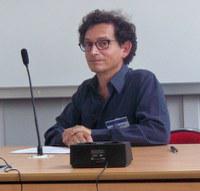Event Date:
Event Date Details:
WHEN: October 31, 2014 at 11:00AM
WHERE: Phelps 4th Floor, Wofsy Room
Event Location:
- Phelps 4th Floor
- Wofsy Room
Raúl Aranovich, UC Davis
A salient feature of Spanish ditransitives is the optionality of Dative Clitic Doubling (DClD) of the goal/beneficiary. In this talk I argue that the function of DClD is to avoid confusion with some themes/patients.
Objects high in the animacy scale are marked with a to differentiate them from subjects, but this neutralizes the distinction between high-animacy patients/themes and goals/beneficiaries. DClD disambiguates the role of the a-marked phrase. Evidence from this analysis comes from a correlation between DClD and word order (among other factors) discovered in a Spanish corpus. DClD is more likely to occur when a goal/beneficiary precedes a theme/patient, sitting closer to the verb. This is where the confusion with an a-marked object can happen. An alternative analysis claims that DClD is analogous to "dative shift", a type of diathesis found in English and other Germanic languages. Evidence against this alternative comes from corpus data, too. In Spanish, DClD is observed with ditransitive verbs like dar 'give', but also in reduced causative constructions with hacer 'do, make'. Corpus analysis reveals no significant differences in DClD across constructions, supporting an analysis of dar as a lexicalized causative. With this assumption, I will argue, a dative shift analysis of DCLD can be developed for either the lexicalized or the reduced causative, but not for both at the same time without additional stipulations. A "differential" Differential Object Marking analysis like mine, on the other hand, applies equally to both constructions, offering a more explanatory account.

